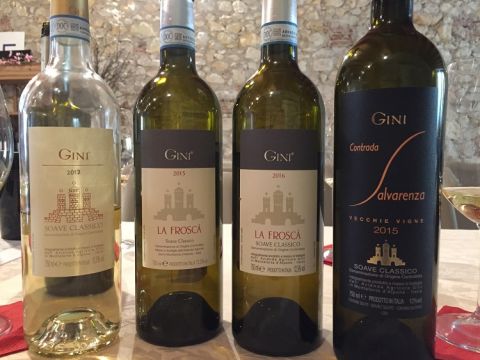From €15.21, 18.31 Swiss francs, $19.99, £16.68
The Gini family have been grape growers and winemakers in Soave for over 400 years. From their cellars and winery in their hometown of Monteforte d’Alpone, and from their 50 ha (124 acres) of vines, they produce some of the finest expressions of Soave Classico wines. Having recently rejoined the Soave Consorzio and with Sandro Gini now president, they are at the forefront of driving quality in the region.
A short drive from Monteforte, up into the hills to the north of the village, are the vineyards that provide the fruit for their two top bottlings. On the east- and south-east-facing slopes of Monte Froscà are their Garganega vines in the Froscà vineyard (pictured), confirmed as a cru in the newly approved system on which I reported in Serious Soave, seriously.
From these vines, Gini produce La Froscà, while from 80- to 160-year-old vines in the heart of the south-east-facing section they make their top Soave Classico: Contrada Salvarenza Vecchie Vigne. As will have been apparent from my Soave article, as well as from previous notes that were included in Our spring 2019 collection – Italian whites and rosés, I have been impressed by Gini’s wines for some time.
While Salvarenza is undoubtedly the finer wine, with extra presence and depth, and is also pretty good value at just under £24 in the UK, it is La Froscà that I am making my wine of the week. I have scored the 2015 17/20 on separate occasions both in London and at the winery, and the same for the 2016 that is just coming onto the market. At £16.68 for the 2015 (and other prices quoted here are also for the 2015), this is certainly good value.
The 2015 La Froscà carries a touch of botrytis, as did the Salvarenza 2015, while the 2016 La Froscà does not. The two wines therefore have subtly different styles, the 2015 being a little richer, honeyed and spicier, while the 2016 has more floral tones, a steelier firmness and possibly a little longer longevity. But both are equally fine wines, gaining complexity from indigenous yeasts for fermentation, extended maturation on lees and with a proportion of older oak.
And for those seeking ‘natural’ wines or 'authentic' winemaking, it is worth noting that Sandro made his first wines without the addition of sulphites in …1985. Today, the wines remain low-sulphite bottlings, with typically around 60 ppm total SO2, much of which will come from the fermentation, rather than from sulphite additions.
As mentioned above, this is available in the UK for £16.68, from importers Justerini & Brooks, and is also widely available across Europe from €16.90 and in the US from $19.99.















